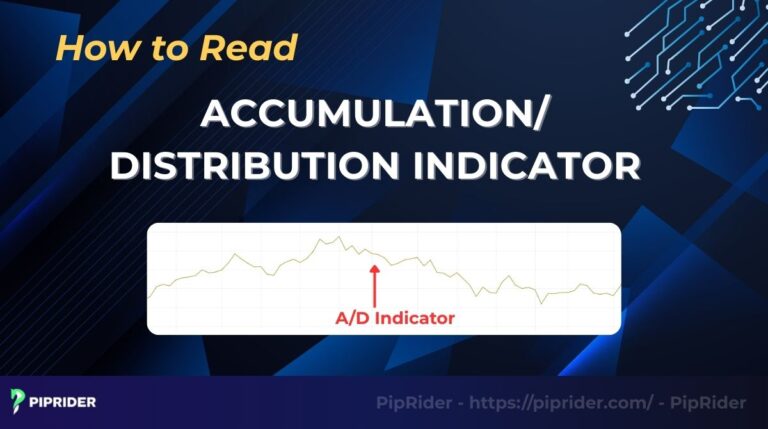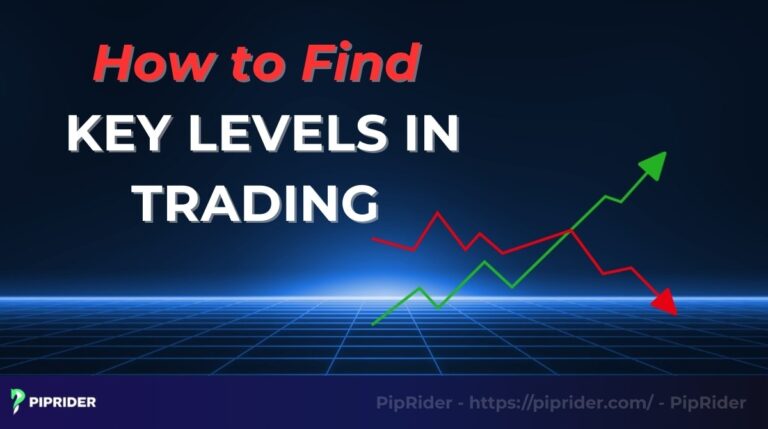Tired of the constant stress and screen time of a more active trading strategy? Position trading offers a calmer, long-term alternative. Instead of chasing small, rapid price movements, a positional trader focuses on capturing the major, macro-economic trends that unfold over weeks, months, or even years. This style blends big-picture fundamental analysis with high-timeframe technical analysis to identify and ride significant market waves.
This guide explains exactly what is positional trading, who it’s for, and the strategies you can use to get started.
Key Takeaways
- A trading method that holds positions for weeks, months, or years to capture major trends.
- Ignores short-term noise, focusing on long-term fundamental drivers and high-timeframe charts.
- Combines fundamental analysis (to find an asset) with technical analysis (to time entries/exits).
- Requires less active screen time but demands significant patience and emotional discipline.
- A great fit for those with full-time jobs who cannot monitor the market daily.
1. What Is Position Trading?

Position trading is a long-term trading style where positions are held for several weeks, months, or even years (IG, 2022). Unlike shorter-term methods, a positional trader is not concerned with minor, daily price fluctuations. Their primary goal is to identify and profit from the major macroeconomic trends that drive a market over an extended period.
Position trading can be applied to various financial products, including stocks, commodities, and is a popular method for position trading in forex. The core idea is to establish an open position in trading and hold it with conviction, riding the primary trend and ignoring the short-term noise.
Position trading style is fundamentally different from day trading or swing trading, which focus on short-term momentum and volatility. A position trader’s success is built on patience and a deep understanding of the big picture.
- Scalping involves extremely short trades, often lasting only seconds to minutes.
- Day Trading requires all positions to be opened and closed within the same trading day and focuses on intraday volatility.
- Swing Trading typically holds positions for several days to weeks in an attempt to capture a single “swing” or price move within a larger trend.
2. Understanding the Position Trader
A position trader operates more like a long-term investor than a typical trader. They are defined by their patience, analytical approach, and focus on the big picture.
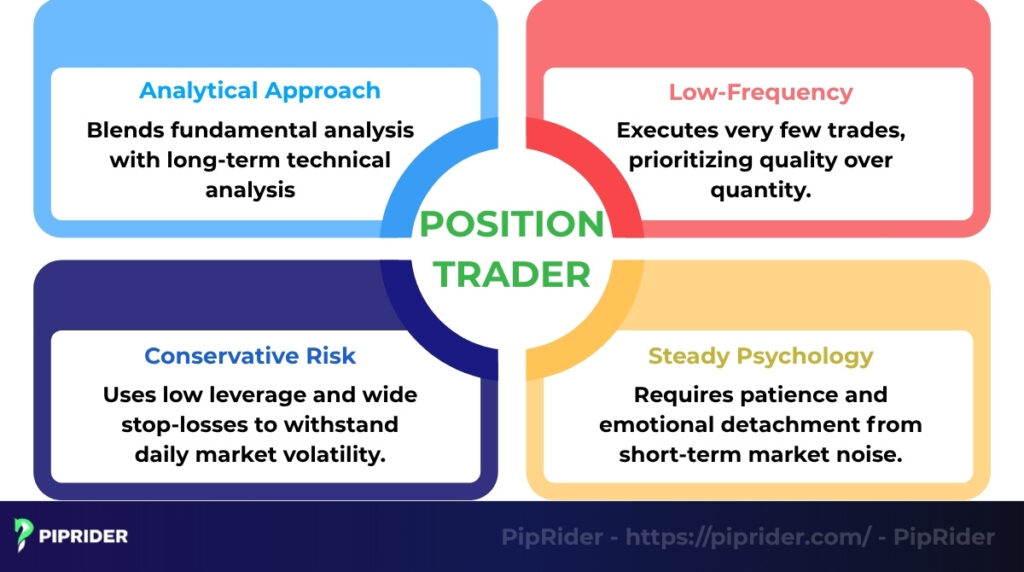
2.1. Key Characteristics
The positional trader has a distinct set of traits:
- Analytical approach: They combine fundamental analysis (to understand why a market is moving) with long-term technical analysis (to determine when to enter and exit).
- Low-frequency trading: Position traders make very few trades, often only a handful per year. Their focus is on the quality of the setup, not the quantity of trades.
- Conservative risk profile: They typically use low leverage and very wide stop-losses to give their trades enough room to breathe and withstand normal market volatility without being stopped out prematurely.
- Steady psychology: A successful position trader is patient and emotionally detached from short-term market noise. They don’t need to monitor their charts constantly.
2.2. How Position Traders Find Opportunities
Position traders hunt for major trends by analyzing the market from a top-down perspective.
Their process usually involves looking at Daily, Weekly, and even Monthly charts to identify a dominant, long-term trend. Once a major trend is confirmed, they use classic technical tools, such as major support levels, resistance levels, trendlines, and breakouts to pinpoint a precise entry. Crucially, their technical view is always supported by a fundamental narrative, such as tracking central bank interest rate policies or major economic shifts.
2.3. Is Position Trading the Right Fit?
Position trading is not for everyone. It is an excellent fit for individuals who:
- Have a full-time job or other commitments and cannot dedicate hours to watching charts every day.
- Are naturally patient and can comfortably hold a trade for months without panicking during a deep retracement.
- Have sufficient capital to handle wider stop-losses and potentially longer periods of drawdown.
3. How Position Trading Works
At its core, position trading operates on the principle of identifying a major, long-term trend and riding it for as long as it remains intact. It’s a strategy based on the “set it and forget it” philosophy, where the initial analysis is far more important than daily management.
A position trader uses long-term trend analysis and price action on high timeframes (like the weekly chart) to form a directional bias. Once they identify a strong uptrend, they will look for a logical entry point to establish long positions, with the intention of holding that position for months. The process is the same for a downtrend, where they would establish short positions.
Unlike short-term styles, risk management is scaled to the long-term view. A stop-loss is placed very wide, often hundreds of pips away, beyond a major technical level. The take-profit is similarly ambitious, targeting a major long-term support or resistance zone. The goal is to capture the majority of a major trend, meaning profits come from the entire, sustained move, not from short-term price swings.
Read more:
Top 12 Forex Trading Strategies Every Trader Should Know
4. Position Trading Strategies
A successful position trading strategy is typically simple and focuses on identifying a long-term directional bias. Rather than complex, short-term signals, position traders use robust, high-timeframe methods to enter and manage their trades.
4.1. The Trend-Following Strategy
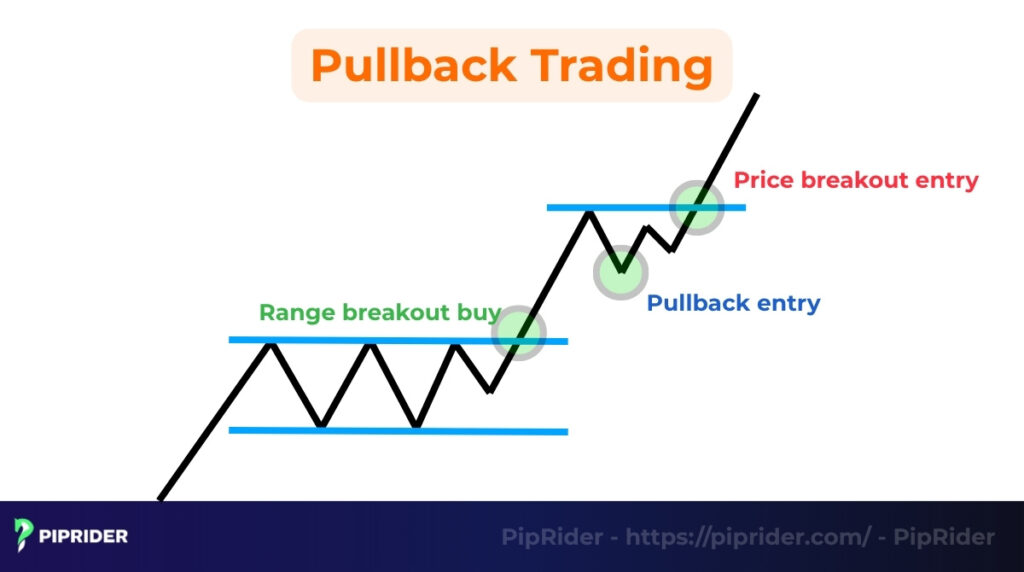
Trend-following is the most common approach, often a form of long-term pullback trading. It uses long-term indicators to define the primary trend and then looks for a low-risk entry point in the direction of that trend.
- Identify the trend: A trader uses long-term Moving Averages, such as the 50-period and 200-period EMAs, on a daily or weekly chart. If the price is consistently above these MAs, the trend is bullish. If below, it’s bearish.
- Time the entry: The entry is taken during a pullback. In an uptrend, a trader waits for the price to retrace back down to the 50-EMA and show signs of support before buying.
4.2. The Breakout and Retest Strategy
This long-term form of breakout trading focuses on identifying major consolidation zones, areas where the price has been trapped in a range for months. The goal is to catch the new trend that emerges after the price finally breaks out.
- Identify the range: A trader draws horizontal lines at the major support and resistance levels that have contained the price for a long period.
- Enter on the retest: After the price breaks out, the trader does not chase it. Instead, they wait patiently for the price to return and retest the broken level as new support or new resistance before entering.
4.3. Position Trading Using Fundamentals
The approach using fundamentals involves making trading decisions based on long-term macroeconomic analysis.
- Analyze the fundamentals: A trader analyzes factors like interest rate policies, inflation data, GDP growth, and geopolitical events to form a long-term directional bias on a currency.
- Hold based on conviction: For example, if a trader believes the US Federal Reserve will continue to raise interest rates, they might decide to hold a long USD position. This trade is held as long as that fundamental narrative remains intact.
5. Example of Position Trading
Let’s walk through a hypothetical forex position trading example on a EUR/USD Daily chart to see how these principles work in practice.
The Setup:
A trader notices that after a long downtrend, the price has decisively broken and closed above its 200-day moving average (MA), a classic signal of a major, long-term trend shift.
The Plan:
- Entry: Instead of buying the initial breakout, the trader waits for a retracement. The price pulls back down to retest the 200-day MA, which now acts as support. A buy order is placed at 1.0800 after a bullish confirmation candle forms.
- Stop-Loss: To absorb market volatility, a wide stop-loss is placed at 1.0600, well below the 200-day MA and the recent swing low. This represents a 200-pip risk.
- Take-Profit: The profit target is set at a major long-term resistance level, identified on the weekly chart, at 1.1300. This creates a 500-pip profit potential.
The Outcome:
The trade is held for six weeks. The price eventually reaches the target, resulting in a 500-pip profit with a strong 1:2.5 Risk-to-Reward ratio.
This same principle can be applied to positions in stock. A trader might buy Apple (AAPL) after it breaks above its 50-week moving average, placing a stop-loss below a recent swing low and holding the position for many months.
6. Advantages and Disadvantages of Position Trading
Like any trading style, position trading has a unique set of pros and cons. It’s an excellent fit for some personalities but completely unsuitable for others.

6.1. Advantages
For traders with the right temperament, this long-term style offers several significant benefits that align with a less stressful, big-picture approach.
- Ability to capture major trends: The biggest advantage is the potential to capture the entirety of a major market move, leading to substantial profits from a single trade.
- Reduced time commitment: Since it operates on high timeframes, there is no need to constantly monitor charts. A position trader might only check their positions once a day or even once a week.
- Lower transaction costs: Because trades are infrequent, the impact of spreads and commissions is significantly reduced compared to short-term trading styles.
6.2. Disadvantages
However, this long-term approach is not without its significant challenges and requires a specific mindset to manage its inherent risks.
- Higher capital requirement: Position trading necessitates wide stop-losses to absorb volatility. This means a trader needs a larger account to handle the potential drawdowns and still adhere to proper risk management rules.
- Slow profit generation: Profits take a long time to materialize. This style demands immense patience and is not suitable for those seeking quick, frequent returns.
- Exposure to major event risk: Holding a position for months exposes a trader to significant overnight gap risk and the danger of a sudden, unexpected event (like a central bank policy shift) causing a violent trend reversal.
7. Risk Management in Position Trading
Because position trades are held for so long, risk management is less about avoiding small losses and more about surviving major market swings. The goal is to set up a trade that can withstand months of volatility without getting stopped out prematurely.
- Limit your margin usage: A position trader should use very low leverage and keep their margin used well below 20% of their total account equity. This creates a large buffer to absorb deep pullbacks without facing a margin call.
- Use multiple, smaller positions: Instead of going “all-in” on a single entry, it’s often wiser to open a smaller initial position. This allows a trader to add to the trade at a later date if the trend continues, while still controlling overall risk.
- Place stops based on structure: Stop-loss orders should not be based on an arbitrary pip amount. They must be placed logically beyond a major technical zone, such as below a major swing low or a long-term moving average, that would invalidate the entire long-term trade idea if broken.
- Monitor major fundamental events: While position traders ignore daily noise, they must stay aware of major economic events that could fundamentally alter a long-term trend. Key events to watch include central bank meetings (FOMC), inflation reports (CPI), and employment data (Non-Farm Payrolls).
8. Position Trading vs. Other Trading Styles
To understand position trading, it’s helpful to see where it fits on the trading spectrum. The main difference between trading styles is the holding period, which in turn dictates the strategy, risk, and psychological demands.
Here’s a simple comparison:
| Style | Holding Time | Focus | Risk | Frequency |
| Scalping | Seconds to Minutes | Tiny price moves | Very High | 50-100+ / day |
| Day Trading | Intraday | Short-term volatility | High | 5-10 / day |
| Swing Trading | Days to Weeks | Medium-term trends | Medium | 2-5 / week |
| Position Trading | Weeks to Years | Long-term trends | Low-Medium | 1-3 / month |
As the table shows, position trading is the slowest of the four styles, requiring the most patience but also involving the least amount of active management.
9. Position Trading for Beginners
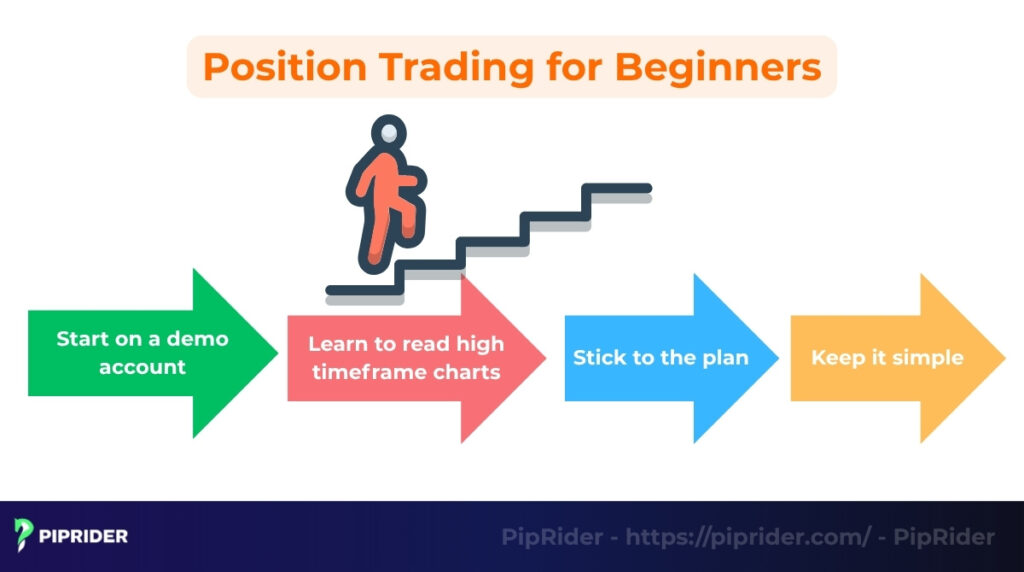
For those new to the style, position trading can be psychologically challenging. Here are a few tips to ease into this long-term approach.
- Start on a demo account: Before risking real capital, practice on a demo account. The goal is not just to test a strategy but to train your patience and get comfortable holding a trade for weeks without interfering.
- Learn to read high timeframe charts: Get comfortable analyzing weekly and monthly charts. This is crucial for identifying the major, long-term market flow that forms the basis of any position trade.
- Stick to the plan: The biggest challenge for beginners is the urge to meddle. Once a trade is placed with clear take-profit orders and a stop-loss, a beginner must learn to step back and let the market do the work. Avoid the temptation to constantly adjust the position based on daily news or price swings.
- Keep it simple: Use a combination of a few reliable, long-term tools. A simple strategy using Moving Averages, the RSI, and basic trendlines is often more effective than a complex system with dozens of indicators.
10. Frequently asked questions about Position Trading
11. Conclusion
Position trading is a powerful, long-term strategy that allows traders to capture the most significant market trends. Its effectiveness comes from a patient and disciplined blend of technical and fundamental analysis, making it a perfect fit for busy individuals who prefer a “set it and forget it” approach.
While it requires a different mindset than short-term trading, the core principle is simple: “trade less, profit more.” By focusing on the big picture, a position trader can build a robust strategy that thrives on major market movements.
To learn more about this and other powerful approaches, follow Piprider and explore our in-depth guides in the Trading Strategies section.



